Noah Baumbach‘s White Noise, an adaptation of Don DeLillo’s 1985 novel of the same name, is a very different film for the filmmaker behind The Squid and the Whale and Marriage Story. The Netflix film stars Adam Driver and Greta Gerwig (Baumbach’s partner and frequent collaborator) as university professor Jack Gladney and his new wife, Babette, who have recently created a new blended family together. When an “airborne toxic event” strikes, they’re forced to abruptly flee their home and hit the road in search of safety.
Set in an alternate version of the ’80s, White Noise is a very different film for Baumbach, not only because it’s the rare project that he adapted rather than wrote himself, but also because Baumbach and Cinematographer Lol Crawley use bright colors to give the film a very different look than the director’s previous work.
Claire Kaufman, SDSA, was the Set Decorator on White Noise, which features stellar work from the entire art department in creating the ’80s-styled environments for the Gladney family, including their home and the supermarket that the entire community frequents.
Below the Line spoke with Kaufman over Zoom a few weeks back for this rather enlightening conversation about set decoration and working with the meticulous Baumbach in particular.
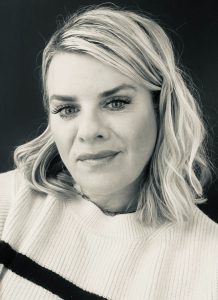
Below the Line: Let’s start with the basics — what is your background, and how did you first get into set decoration?
Claire Kaufman: Set decoration came to me very early. I was 20 years old. I had done my couple of years of college, and I just wanted to come to L.A. for the summer. I ended up on some music videos, and that led to commercials for about 10 years, and then television and finally, features, which is where I really have always wanted to be.
BTL: I assume the production designer or art director brings you in, so do you generally work with the same production designers and filmmakers?
Kaufman: I was on a television show for seven years, which was a blessing and also a curse, because you come off a show after seven years and realize, “Wow, I really need to meet some new people.” It’s been a build-up since then. I was lucky enough to meet [Production Designer] Jess [Gonchor], and we’ve done a couple of great movies together. We originally had done some commercials together. We did a big Apple job together, and then he was like, ‘when the timing works, and we can do a project together, that would be great.’ And then that happened on Little Women, and that was amazing.
BTL: When you found out about White Noise, did you read Don DeLillo’s book? Is that typically part of the research or prep you do?
Kaufman: Oh, immediately. I’m a product of the ’80s, but I hadn’t actually read that book. So Jess brought the project to me [and] I immediately went out and read the book. It’s a long read, but anytime I can read a book… Obviously, I’d read Little Women, but I immediately went back and read that again. I love what Noah did with the screenplay [for White Noise]. I think it’s incredible because it is such a monster of a book. People have [said it] was unfilmable, and I think it’s amazing what he captured in his screenplay.
BTL: Books can obviously be quite descriptive, but I’m not sure if DeLillo goes so far as to describe everything on a shelf, for instance, or what an office or house looks like. They’re rarely that descriptive. So what were you able to get from the book and apply to the movie?
Kaufman: It’s funny, because Jess and I talked about that. The book is actually not very descriptive at all. For me, it was more talking about the family and [their] backstory. It’s just such an interesting character study to do because it’s this blended family [from] four marriages [with] all these kids. In the book, there are actually more kids, so that helps give the backstory, for me. [That] was probably the most important thing I took away from the book.
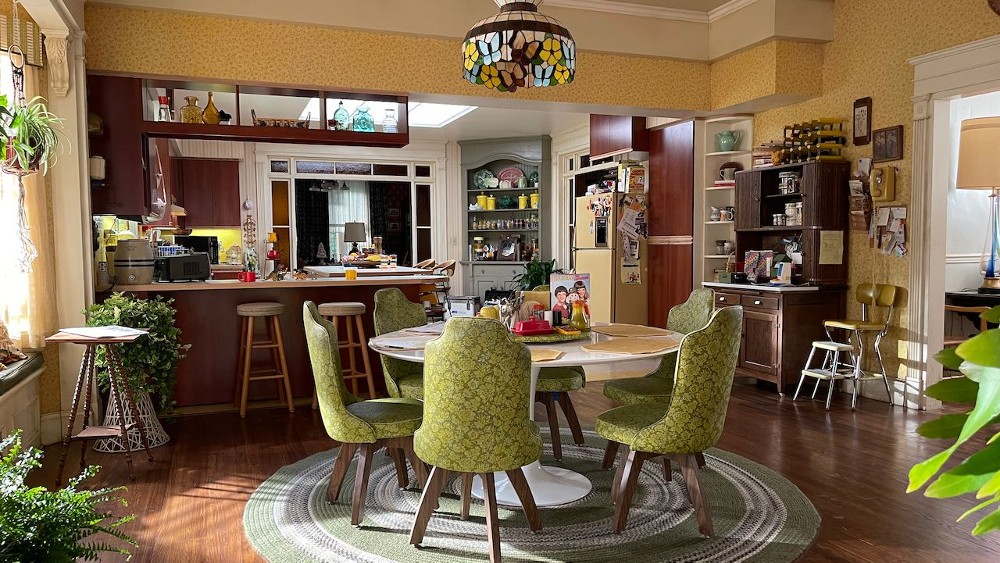
BTL: Do you assume that because it’s a blended family they have a lot of leftovers from past marriages?
Kaufman: No, we talked a lot about this house [being] a vessel for all of their lives. You’ve got wives that have probably decorated one room in the house. The idea was that Jack’s been at this university for at least 16 years. This house came from the university — there are leftover bits and pieces. It was also very important to me, because of the longevity [and how long] this family has been in the house, that it wasn’t all ’80s, that there were leftover bits from lives past and peoples’ past. And then, the idea was… Jess and I talked about how the Gladney kitchen is really just an extension of the supermarket. Even for their bedroom, I had this idea that Jack and Babette went out and bought this brand new bedroom set and redid parts of the bedroom. There was kind of bringing in all these different levels and different pieces from different times.
BTL: Are you involved with selecting the color schemes for their house, or is that something you come up with working alongside Jess?
Kaufman: Well, it’s definitely working together. I was lucky to have this amazing space in Cleveland, where I was able to arc the film from beginning to end and really look at each set and each piece and how the film was going to [look all the way] through to the end. I was able to walk through with Jess and Noah and look at that. Jess and I talked a lot about the Rubik’s Cube and how that was the color palette that we used throughout the entire film, which I think really comes across.
BTL: This is a very different film for Noah because movies like The Squid and the Whale and Marriage Story don’t have bright, blazing colors, whereas White Noise has such an interesting color palette. In that sense, it might feel more like real life than even Marriage Story did.
Kaufman: It is a real departure for Noah, and even when we talked about the house… for me, it’s so important that you walk into any set and you are fully immersed in that set. You believe that you are in the Gladney house. [If] you opened any drawer, any cupboard, any closet, they were dressed, whether we saw them or not. You just really want to give that feeling that you are in this house with all of this stuff. The other great part about Noah is he does these rehearsals, so you have a real understanding of how the scene is gonna play out [and] where the actors are going. Even the scenes in the kitchen, we talked about, so they’d rehearse basically in an empty space, and then they’d be like, ‘We need glasses here and this drawer here.’ [The same] in the supermarket as well. It was such a great way to be able to work because I had a real understanding of where actions were going to take place and [which] areas were most important to dress.
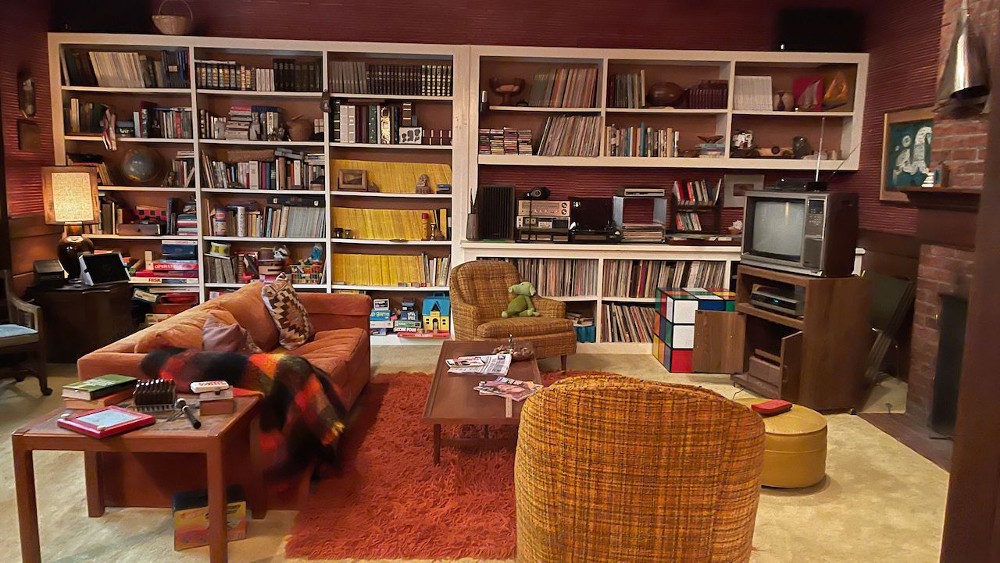
BTL: What’s your timeframe for getting involved? I assume that as the production designer, Jess would be involved early enough to go to locations and figure out what needs to be built. At what point do you get involved, and is that even before any construction begins?
Kaufman: Jess definitely did a lot of scouting; I think he looked in several states, and then they finally landed on Cleveland. And then I’m brought out, and even once I’m there, Jess is location scouting, and we’re looking at places, and then I kind of go away and really start curating a warehouse where I do each set and start really looking for specific things and things I believe are going to be amazing in each of these sets, and [I] spend all this time shopping and curating the stuff together. I bring wallpapers and carpets, and we look at all that kind of stuff. Denise’s bedroom is a really good example. Noah had said to me that he wanted Denise to look like she was in a field of flowers, which I loved. I instantly looked at all these wallpapers and nothing was working, and then I actually found that vintage bed, bedspread, and pillow case, and we ended up printing the wallpaper and making matching drapery, and that’s kind of how that set evolved.
BTL: Since you were filming in Cleveland, did you end up hiring a lot of crew out of there, and were you able to find everything you needed to source there, or did you still have to ship things in?
Kaufman: It’s a mix. I mean, to be honest, we sent a few things out from L.A., but it was more like the streetlamps that are outside the motel, things that I was concerned I might not be able to source. I will tell you the shopping in Cleveland, to do an ’80s movie, was phenomenal.
BTL: Are you suggesting that there were places in Cleveland that were stuck in the ’80s?
Kaufman: A little bit, parts of it, for sure. The antiquing was amazing, but we sourced wallpapers from L.A. and I have a fabric vendor in Boston that we got stuff from, so it’s kind of all over the place, but we were able to actually do a lot of the movie out of Cleveland as far as the bulk of it.
BTL: I want to go through some of the spaces specifically, and we can leave the supermarket for last. Let’s start with Jack’s office at the university, which is quite odd because he specializes in Hitler, which requires some very specific set decoration that I imagine might get you some strange looks.
Kaufman: Interesting, [because it was] a very difficult set to do because it was so important to Noah and everyone involved [that] Jack is not a fan. He is coming [at Hitler] from an academic place, he’s cornered this academic world, but it was so important that he never came across as somebody who was a fan. I tried to get that across in some of the posters that are kind of [caricatures] of him and funny, odd pictures of him. It was difficult because you didn’t want him to come across as a fan.
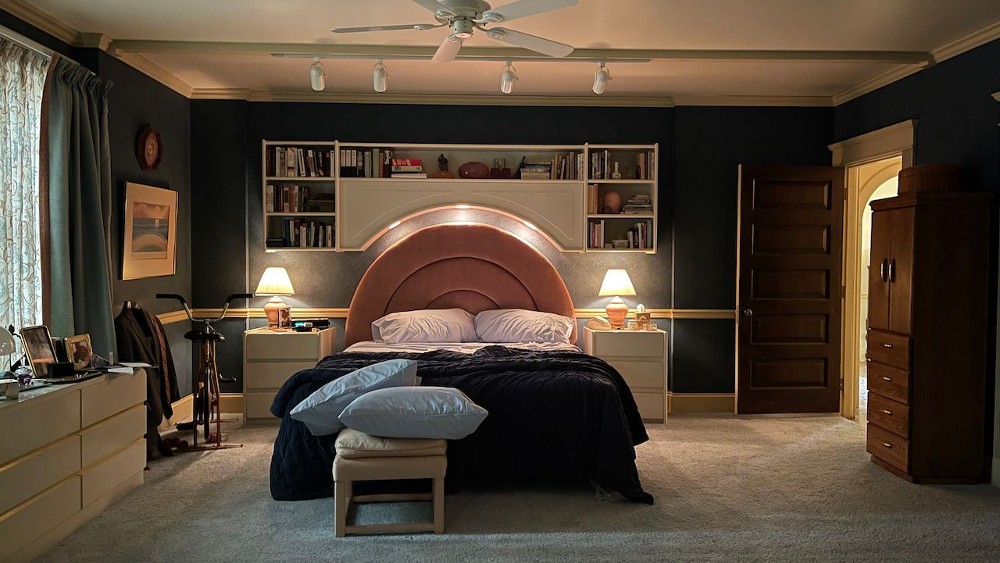
BTL: You talked a little about the Gladney house, which was interesting because you could look at the shelves and see what’s on there and learn a lot about the family. Did you get ideas for that from the book or Noah’s script?
Kaufman: A little bit. A lot of it is us coming and putting these sets together and me swatching fabrics, and textures and wallpapers and shopping furniture, and then sitting down with Jess and talking about who this family is, and things like the attic and the garage. We were going in and going to estate sales and clearing out people’s basements and ripping carpets out of old dens that they didn’t want, just to really give it this believability and this texture [so] that you really believe this stuff belong in this house. So it’s a mix, and then there was a lot of stuff we made, [like] almost all the drapery in the house. I had the headboard made… what else? [The house is] really a vessel for their lives; I don’t know how else to explain it.
BTL: From talking to production designers, I do pay a bit more attention to that element while watching movies, and I’m always amazed when there’s this amazing location that’s really only there for a two-minute scene. So is there stuff you’re dressing that never even ends up on camera? And is that frustrating or just something you’re used to?
Kaufman: Yeah, you dress for any camera angle. Sometimes, it’s heartbreaking. Sometimes, it’s amazing. I feel like Lol [Crawley], the DP, really did us a lot of justice in this film, and they really do showcase a lot of the sets, which was great. I’m not gonna lie, there are parts of the house we don’t see, but that is just part of what comes along with it. I give 1,000 percent every time, no matter what.
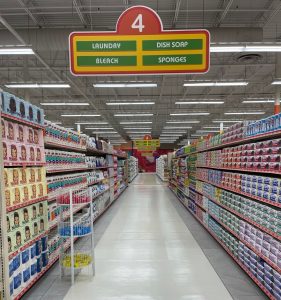
BTL: Let’s talk about the supermarket because that’s another great location. Was it an existing empty supermarket that you dressed up or was there already stuff there that you could use?
Kaufman: It’s definitely a big box store. I think it was more like maybe a Target or a Walmart kind of situation, and it was completely empty. The one thing that was there was the shelving, which we completely reorganized and redid, and laid out. We closed a bit of the space because it was so massive. In the beginning, that was really daunting, but for me, it ended up being such a blessing, because then I really did get to pick and choose every single product, every single thing. I wasn’t having to work against [something] and try to make something work that was already there. We got to completely decide how it was going to be laid out.
BTL: Are you creating the boxes as fronts on the shelves or are there real products on the shelves?
Kaufman: Every product is at least two-deep. The idea was if somebody came and took a product off the shelf that there was something behind [it]. We made a conscious choice that it’s always perfect; there’s always somebody restocking the shelves. It was something that Jess and I talked about, and we decided that it’s this magical place, and it’s always stocked, always full, and that was kind of the idea behind that.
BTL: Were there any visual effects involved with creating that supermarket, even if only for backgrounds? Do you get involved in that aspect of set dressing as well?
Kaufman: We definitely talked through it and what it was going to be. I will tell you about 85 percent of that, even when they come up over the shelves and do what we call the big high wide shot, basically, 85 percent of that is from us. There are visual effects in the back and kind of filling in. Almost all of it is real product. We did do some prints for shelving, which was just a flat cardboard piece that was a very deep background that actually worked really well for us. If they came around a corner, or we saw something in a deep background, then we were able to dress, but we dressed about 6,700 linear feet of shelving.
BTL: I don’t know when they shot the supermarket scenes during the shoot, but how long did it take to turn that abandoned supermarket turned into what we see in the film?
Kaufman: Jess and the carpenters and the painters and Chris [Farmer], the Art Director, worked in there for a while. While they were kind of enclosing some of the space and putting some walls in, I had my team in there, relaying out all the shelves. [We], as a department, spent about six weeks redoing the aisles, making the product, [and] rewrapping stuff. It was basically just an assembly line of people that I had out there for about six weeks.
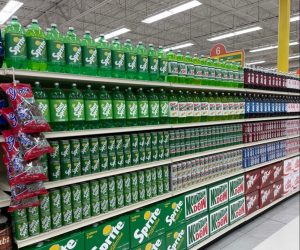
BTL: That brings us to product placement. I’m really interested not just in the supermarket, but also in the things we see around the house, since there are very specific ’80s products like Tab. Although Don DeLillo’s book takes place in a fictitious ’80s, you clearly had to find some real products for both the house and the supermarket. Did you have to get clearances for all the different products we see? Were there companies that provided their products for the movie?
Kaufman: Netflix is great when it comes to stuff like that. [With] the supermarket, I think the idea was always… even when I’ve shot on other shows and we’ve gone into a convenience store or supermarket, it’s this idea that if you’re not misusing the products in any way [and] if you’re using them the way they’re supposed to be used or shopped, it was just a supermarket. So, there are eight different brands of chips on the shelves that we don’t have to clear them. That’s always been a rule of thumb that I’ve gone by, and Noah didn’t want to see fake products. That was not really an option for us.
BTL: What about the random items we see in the house? There’s a lot of product placement, either stuff they’re using or just sitting on a table. Did Noah have any ideas of what products he wanted there in the house?
Kaufman: It was funny because we did the house before we did the supermarket. Afterward, I had more products that I knew what to do [with]. By the time we got to the gas station, and had to dress parts of the gas station, I was like, ‘Great. We’ve got more food products than we know what to do with.’ But yeah, it was working with the prop master, Ed [J. Borasch Jr.], and myself. Like I said earlier, it was this extension of the supermarket where the fridge is full, and the cupboards are full. Even the Corn Niblets that she’s holding, that’s actually something scripted from the book.
BTL: That brings me to a question you can probably answer. I’ve been told that anything placed on a set is set decoration… unless the actors have to interact with something, and then it becomes a prop. How does that work with what you’re doing? If you put a toaster on a shelf in the background, but then the actor puts in a piece of toast, does that toaster become the responsibility of the prop master?
Kaufman: Every prop master is different for me. I really like to be about the look, so we picked all the dishware, all the glassware, all the silverware, but then, at some point, it gets turned over to the prop master. It’s just a very great working relationship most of the time, where they bring stuff to the table, I bring stuff to the table, we talk about it, [and] we talk about who’s going to supply what? “How many resets do you need?” All that sort of stuff, so some are more fun than others.
BTL: What happens to all those products after you’re done with the shoot? Are they donated or something?
Kaufman: We donated a huge portion of it. I think a lot of the produce went to farm animals and lots of women’s shelters [got] paper products. You try to be, obviously, as least wasteful as possible.
BTL: You worked with Jess before, but generally, are your teams very similar from show to show, or are there different folks coming in who you have to figure out how to work with and vice versa?
Kaufman: Everybody has a different way of doing it. For me, it’s just a ton of research. I try to bring a lot of knowledge to the projects, no matter what. Every designer works differently. Some are way more hands-on, and some are hands-off. But Jess is great. We have a really great working relationship because it’s very collaborative, and for me, I think that shows when you see a film like this. The vessels and the buildings and the rooms are working with the set dressing, and that’s because there was a lot of talk and a lot of communication.
BTL: I presume that Jess used a lot of local builders and carpenters. Is that the same on your end of things? Do you have people you bring in, or do you put together a local team in Cleveland?
Kaufman: I brought on one buyer, we call them, from Los Angeles with me. Jess had actually worked with my lead man, Lance [Walters], on a previous project. And I would now consider Lance one of my dearest friends, and I would not have wanted to be in the trenches with anybody but him. The crew was amazing. I couldn’t speak more highly of the crew that I was able to put together in Cleveland. They were amazing.
BTL: I’m sorry but I haven’t heard the term “lead man” before.
Kaufman: Basically, there’s me as the department head, and then I have my lead man [who] is my right-hand person. He runs the crews, and he makes sure all the things that I buy or rent get picked up and left at the right location and gives everybody their call times and deals with other departments when there’s rigging, from electric and grip and all this sort of stuff. And then, I had two buyers — one from Los Angeles and one from Cleveland — and they’re out helping me swatch fabrics and find pieces and buy curtain rods, anything [really]. That’s just their position, basically.
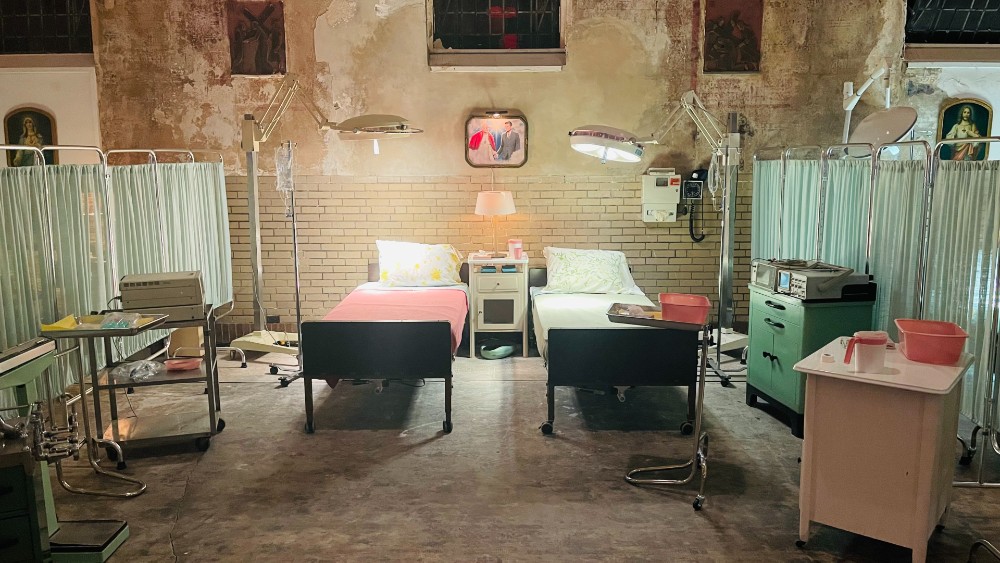
BTL: What was the hardest thing to find that you definitely had to have and eventually found, but it took a longer time than normal? Do you get obsessive about that stuff?
Kaufman: Not too bad. [laughs] One thing that was very clear from the beginning and one thing we did actually pull from Los Angeles was, there are so many televisions, and every television has to do playback, and that’s a very specific thing. I knew from the [start] that I wanted to pull televisions from Los Angeles. What we did find were all these amazing vintage computers, and probably the hardest things to find were eight matching 1980s cash registers [for] the supermarket. Three of them [actually] worked, which was amazing. So that was a find and a coup.
BTL: Do you generally prefer doing period stuff? I know that with costumes, period can be fun, but is that the same with set decoration? Is it more fun to do period than modern-day?
Kaufman: I love all of it, to be honest with you. Not to sound cliché, but period is amazing — specifically with this movie because I am a product of the ‘80s, unlike doing Little Women. It was so much research, [but] I really knew and came from the ’80s. Every project is different, but I do love doing period stuff, for sure.
BTL: That’s a good segue to my next question because I know you went on to work on Christopher Nolan’s Oppenheimer, which goes back even further in time to the ’40s. Was that fun to do? Did you shoot it in London or Los Angeles?
Kaufman: It shot here in Los Angeles and in New Mexico. He’s an incredible filmmaker to work with, hands down, and that project was fun because it was [the] ’30s, ’40s, and ’50s. Again, it’s just making it right, and it’s all in the details for me; it’s really [about] making it believable.
BTL: Did you work with his regular production designer, Nathan Crowley, who has received six Oscar nominations for his work with Nolan?
Kaufman: Actually, it was a woman [Ruth De Jong], and it was the first time she had worked with him as well.
BTL: Was she someone you had worked with before?
Kaufman: No, that was the first time we’ve worked together, so it was good, and I would work for Christopher Nolan any day.
White Noise is now streaming on Netflix. Click here to read our interview with the film’s cinematographer, Lol Crawley.





